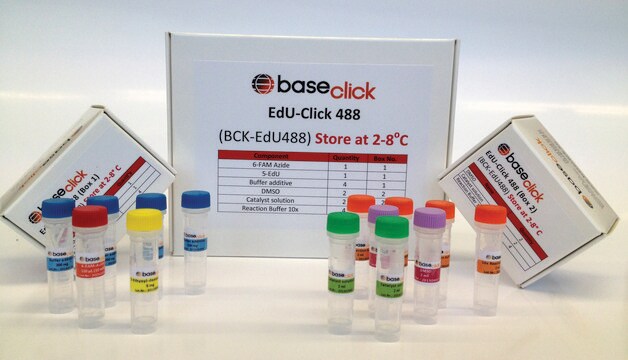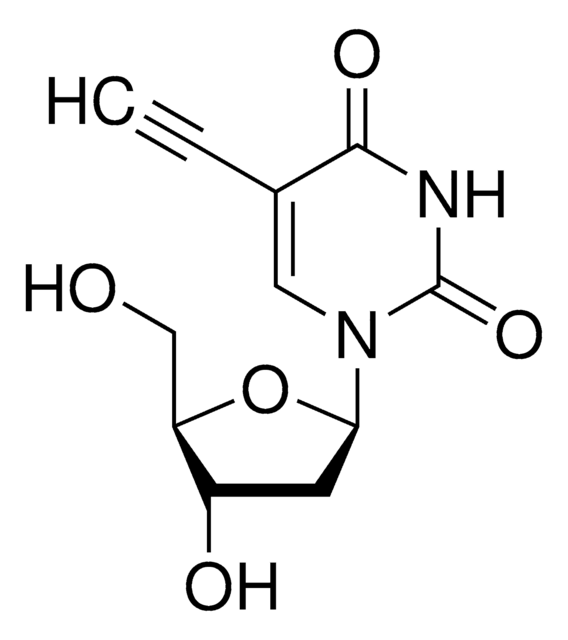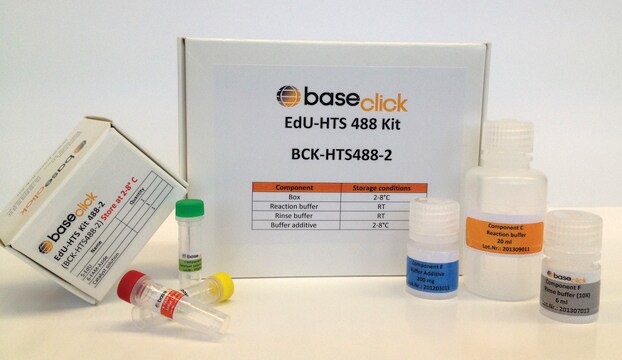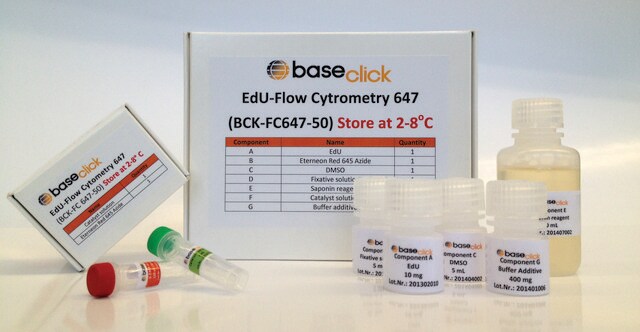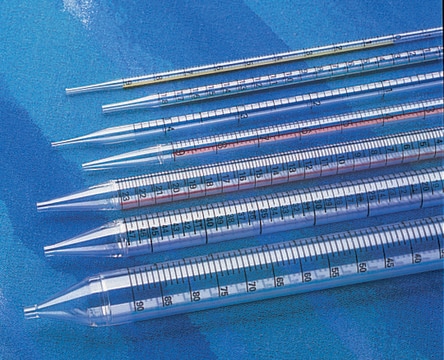BCK-EDU488
EdU-Click 488
sufficient for 100 assays
Synonym(s):
EdU Cell Proliferation Kit
Sign Into View Organizational & Contract Pricing
All Photos(1)
About This Item
UNSPSC Code:
12161503
NACRES:
NA.22
Recommended Products
fluorescence
λex 496 nm; λem 516 nm
shipped in
wet ice
storage temp.
2-8°C
General description
EdU (5-ethynyl-2′-deoxyuridine) is a nucleoside analog to thymidine and is incorporated into DNA during active DNA synthesis. In contrast to BrdU assays, the EdU-Click Assays are not antibody based and therefore do not require DNA denaturation for detection of the incorporated nucleoside. Instead, the Baseclick EdU-Click Assays utilize click chemistry for detection in a variety of dye fluorescent readouts. Furthermore, the streamlined detection protocol reduces both the total number of steps and significantly decreases the total amount of time. The simple click chemistry detection procedure is complete within 30 minutes and is compatible with multiplexing for content and context-rich results.
Application
Imaging
Signal Word
Danger
Hazard Statements
Precautionary Statements
Hazard Classifications
Aquatic Chronic 3 - Eye Irrit. 2 - Muta. 1B - Repr. 2
Storage Class Code
6.1C - Combustible acute toxic Cat.3 / toxic compounds or compounds which causing chronic effects
Certificates of Analysis (COA)
Search for Certificates of Analysis (COA) by entering the products Lot/Batch Number. Lot and Batch Numbers can be found on a product’s label following the words ‘Lot’ or ‘Batch’.
Already Own This Product?
Find documentation for the products that you have recently purchased in the Document Library.
Drake S Edwards et al.
Cell reports, 32(12), 108166-108166 (2020-09-24)
Effective spatio-temporal control of transcription and replication during S-phase is paramount to maintaining genomic integrity and cell survival. Dysregulation of these systems can lead to conflicts between the transcription and replication machinery, causing DNA damage and cell death. BRD4 allows
Yongmao Yu et al.
Journal of immunological methods, 350(1-2), 29-35 (2009-08-04)
T lymphocyte proliferations can be measured by [(3)H]thymidine incorporation. However, many labs avoid this technique because of the need to use radioactive substrates. In addition, [(3)H]thymidine incorporation method does not permit simultaneous characterization of the proliferating cells. We developed the
Fatemah Chehrehasa et al.
Journal of neuroscience methods, 177(1), 122-130 (2008-11-11)
Labelling and identifying proliferating cells is central to understanding neurogenesis and neural lineages in vivo and in vitro. We present here a novel thymidine analogue, ethynyl deoxyuridine (EdU) for labelling dividing cells, detected with a fluorescent azide which forms a
Our team of scientists has experience in all areas of research including Life Science, Material Science, Chemical Synthesis, Chromatography, Analytical and many others.
Contact Technical Service